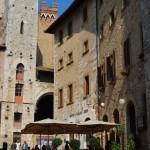SAN GIMIGNANO (TUSCANY)
San Gimignano – is one of the most scenic and most visited by tourists towns in Tuscany. Since 1990, it is an object of the World Heritage List. As of 2005, the population of the city was 7,105 residents.
Every year around 3 million tourists visit this little town, which occupies the area of only 1,640 feet by 2,950 feet.
During the Hellenistic period (200-300 B.C.), San Gimignano was a small Etruscan village and it obtained status of a town around X century A.D.
The city received its name after the name of Modena’s bishop – San Gimignano, who, as one legend has it, stopped barbarian hordes of Attila at the walls of the city in IV century.
San Gimignano saw the boom of its economical and architectural development in the Middle Ages mostly due to Via Francigena – trade and traffic route connecting Rome and France, which crossed the premises of this city.
In 1199, San Gimignano became a free city under its own self-government and started to war against the bishop of Volterra and other neighboring self-governed cities. Internal discord resulted in the city’s being divided into two factions: one was headed up by Ardinghelli family (Guelphs), while the other — by Salvucci family (Ghibellines).
On May 8 of 1300, San Gimignano was visited by Dante Alighieri in status of an “Ambassador of the Guelph League in Tuscany.” The local population significantly decreased in 1348 because of an epidemic of “Black Death,” which plunged the city into a serious crisis and eventually became the reason of its submission to Florence in 1353. In the following centuries, San Gimignano was able to overcome the state of recession and isolation due to restoration of its former beauty, cultural significance and agricultural heritage.
Since that time the city has not changed much and wonderfully preserved its medieval appearance, including city walls and fourteen stone towers — “skyscrapers of the Middle Ages.” There used to be 72 of them originally and they were built by the noblest families to emphasize their social status.
Among the buildings and homes-fortresses surrounding San Gimignano’s main square the tallest tower of the city — Torre Grossa — strikes with its particular stature shooting into the sky for 54 meters.
In our days, tourists can enjoy sheer fairy tale enchantment of the past centuries: narrow streets, splendid houses and churches, small porticoes and arched passways joining buildings at the top.
Within medieval San Gimignano there are beautiful monuments of Roman Gothic architecture: Collegiata cathedral (1148) and Sant’Agostino church (1280), Palazzo del Popolo (1288) and Palazzo Podesta with a mighty Ronioso tower (1239), and also a wonderful museum, in which the art of Siena and Florence cultural schools is kept.
In San Gimignano there is a museum of Tortures with genuine torture tools of XV-XVIII centuries. Modern means of legal murder — electric chair from Alabama (USA) is also represented here.
In small taverns visitors are treated to traditional Tuscany dry wines and ham of wild boar meat.
Entrances to local shops of meat delicacies are adorned with wild boar heads, while inside whole boar legs are hanging, off which magnificent prosciutto is thinly sliced. You will definitely discover special places, where hearty hospitable people make their own wine and oil; even though their product is not widely known, it is still wonderful. You will be served a tasty dinner and hosts will happily respond to your every word, even if it is spoken in a very approximate Italian.
If you happen to be in San Gimignano at the end of June you will witness Ferie Delle Messi (medieval feast of the harvest) and watch how the narrow streets are filled with medieval crowd and knights riding to the square Piazza della Сisterna. Every year, the Association of St. Fina holds Giostra dei Bastoni tournament here (tournament for knights fighting with sticks). This colorful event gathers huge crowds of spectators. Each year, plays are staged in the open air; international festival of culture and summer festival of opera and ballet are held.

